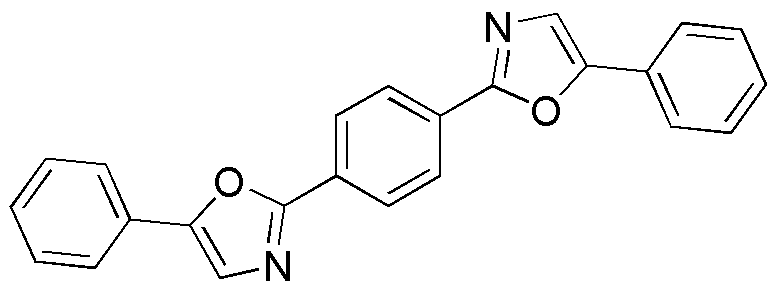1,4-Bis(5-phenyl-2-oxazolyl)benzene is widely utilized in research focused on:
- Fluorescent Materials: This compound is used in the development of fluorescent dyes and materials, which are essential in various applications such as bioimaging and sensing technologies.
- Organic Light Emitting Diodes (OLEDs): It serves as a key component in OLED technology, enhancing the efficiency and brightness of displays in consumer electronics.
- Polymer Chemistry: Researchers incorporate this compound into polymers to improve their optical properties, making them suitable for advanced coatings and films.
- Photovoltaic Cells: Its unique properties contribute to the efficiency of organic photovoltaic cells, aiding in the development of sustainable energy solutions.
- Biological Research: The compound is also explored for its potential in biological applications, including as a fluorescent probe for tracking cellular processes.
General Information
Properties
Safety and Regulations
Applications
1,4-Bis(5-phenyl-2-oxazolyl)benzene is widely utilized in research focused on:
- Fluorescent Materials: This compound is used in the development of fluorescent dyes and materials, which are essential in various applications such as bioimaging and sensing technologies.
- Organic Light Emitting Diodes (OLEDs): It serves as a key component in OLED technology, enhancing the efficiency and brightness of displays in consumer electronics.
- Polymer Chemistry: Researchers incorporate this compound into polymers to improve their optical properties, making them suitable for advanced coatings and films.
- Photovoltaic Cells: Its unique properties contribute to the efficiency of organic photovoltaic cells, aiding in the development of sustainable energy solutions.
- Biological Research: The compound is also explored for its potential in biological applications, including as a fluorescent probe for tracking cellular processes.
Documents
Safety Data Sheets (SDS)
The SDS provides comprehensive safety information on handling, storage, and disposal of the product.
Product Specification (PS)
The PS provides a comprehensive breakdown of the product’s properties, including chemical composition, physical state, purity, and storage requirements. It also details acceptable quality ranges and the product's intended applications.
Certificates of Analysis (COA)
Search for Certificates of Analysis (COA) by entering the products Lot Number. Lot and Batch Numbers can be found on a product’s label following the words ‘Lot’ or ‘Batch’.
*Catalog Number
*Lot Number
Certificates Of Origin (COO)
This COO confirms the country where the product was manufactured, and also details the materials and components used in it and whether it is derived from natural, synthetic, or other specific sources. This certificate may be required for customs, trade, and regulatory compliance.
*Catalog Number
*Lot Number
Safety Data Sheets (SDS)
The SDS provides comprehensive safety information on handling, storage, and disposal of the product.
DownloadProduct Specification (PS)
The PS provides a comprehensive breakdown of the product’s properties, including chemical composition, physical state, purity, and storage requirements. It also details acceptable quality ranges and the product's intended applications.
DownloadCertificates of Analysis (COA)
Search for Certificates of Analysis (COA) by entering the products Lot Number. Lot and Batch Numbers can be found on a product’s label following the words ‘Lot’ or ‘Batch’.
*Catalog Number
*Lot Number
Certificates Of Origin (COO)
This COO confirms the country where the product was manufactured, and also details the materials and components used in it and whether it is derived from natural, synthetic, or other specific sources. This certificate may be required for customs, trade, and regulatory compliance.

